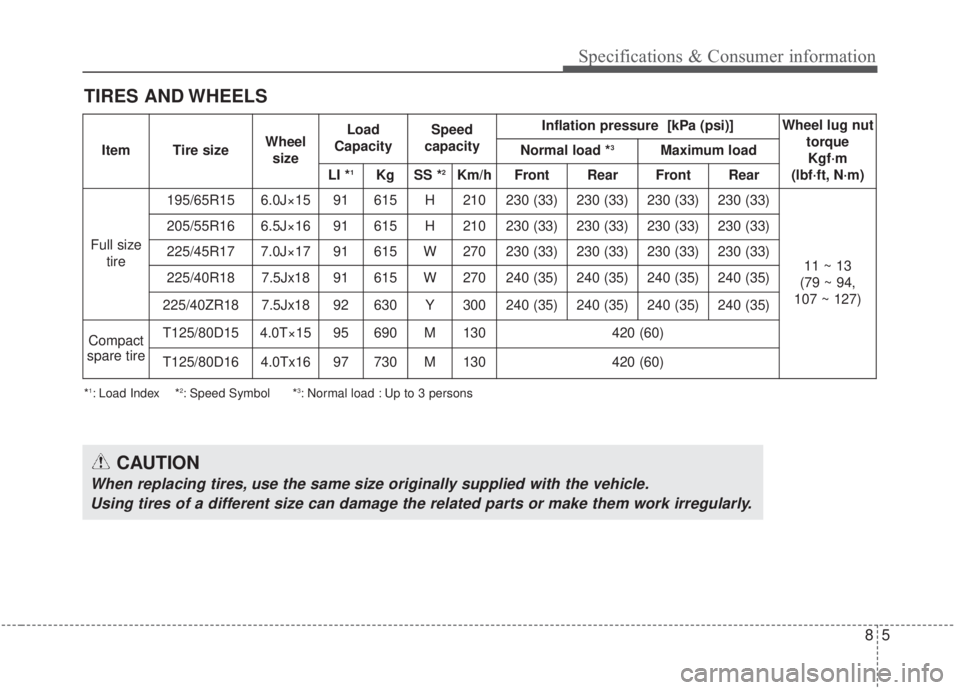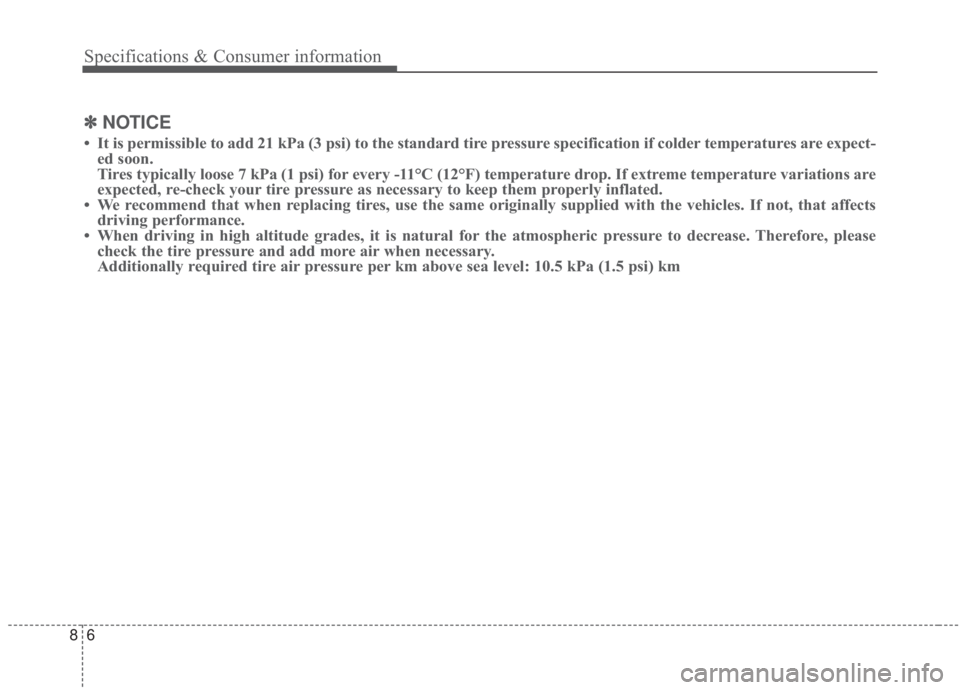2020 KIA FORTE flat tire
[x] Cancel search: flat tirePage 494 of 568

757
Maintenance
Production options weight:The
combined weight of installed regular
production options weighing over 5
lb.(2.3 kg) in excess of the standard
items which they replace, not previ-
ously considered in curb weight or
accessory weight, including heavy
duty brakes, ride levelers, roof rack,
heavy duty battery, and special trim.
Recommended Inflation Pressure:
Vehicle manufacturer's recommend-
ed tire inflation pressure and shown
on the tire placard.
Radial Ply Tire: A pneumatic tire in
which the ply cords that extend to the
beads are laid at 90 degrees to the
centerline of the tread.
Rim: A metal support for a tire and
upon which the tire beads are seat-
ed.
Sidewall: The portion of a tire
between the tread and the bead. Speed Rating:
An alphanumeric
code assigned to a tire indicating the
maximum speed at which a tire can
operate.
Traction: The friction between the
tire and the road surface. The
amount of grip provided.
Tread: The portion of a tire that
comes into contact with the road.
Treadwear Indicators: Narrow
bands, sometimes called "wear
bars," that show across the tread of a
tire when only 1.6 mm (1/16 inch) of
tread remains.
UTQGS: Uniform Tire Quality
Grading Standards, a tire information
system that provides consumers with
ratings for a tire's traction, tempera-
ture and treadwear. Ratings are
determined by tire manufacturers
using government testing proce-
dures. The ratings are molded into
the sidewall of the tire.
Vehicle Capacity Weight: The num-
ber of designated seating positions
multiplied by 68kg (150 lbs.) plus the
rated cargo and luggage load. Vehicle Maximum Load on the
Tire:
Load on an individual tire due
to curb and accessory weight plus
maximum occupant and cargo
weight.
Vehicle Normal Load on the Tire:
Load on an individual tire that is
determined by distributing to each
axle its share of the curb weight,
accessory weight, and normal occu-
pant weight and driving by 2.
Vehicle Placard: A label permanent-
ly attached to a vehicle showing the
original equipment tire size and rec-
ommended inflation pressure.
Page 496 of 568

759
Maintenance
Radial-ply tires
Radial-ply tires provide improved
tread life, road hazard resistance and
smoother high speed ride. The radi-
al-ply tires used on this vehicle are
of belted construction and are select-
ed to complement the ride and han-
dling characteristics of your vehicle.
Radial-ply tires have the same load
carrying capacity as bias-ply or bias
belted tires of the same size and use
the same recommended inflation
pressure. Mixing of radial-ply tires
with bias-ply or bias belted tires is
not recommended. Any combina-
tions of radial-ply and bias-ply or bias
belted tires when used on the same
vehicle will seriously deteriorate
vehicle handling. The best rule to fol-
low is: identical radial-ply tires should
always be used as a set of four.Longer wearing tires can be more
susceptible to irregular tread wear. It
is very important to follow the tire
rotation interval shown in this section
to achieve the tread life potential of
these tires. Cuts and punctures in
radial-ply tires are repairable only in
the tread area, because of sidewall
flexing. Consult your tire dealer for
radial-ply tire repairs.WARNING
Do not use summer tires at tem-
peratures below 7°C (45°F) or
when driving on snow or ice. At
temperatures below 7°C (45°F),
summer tires can lose elastici-
ty, and therefore traction and
braking power as well. Change
the tires on your vehicle to win-
ter or all-weather tires of the
same size as the standard tires
of the vehicle. Both types of
tires are identified by the M+S
(Mud and Snow) marking. Using
summer tires at very cold tem-
peratures could cause cracks to
form, thereby damaging the
tires permanently.
Page 550 of 568

85
Specifications & Consumer information
TIRES AND WHEELS
*1: Load Index *2: Speed Symbol *3: Normal load : Up to 3 persons
CAUTION
When replacing tires, use the same size originally supplied with the vehicle.Using tires of a different size can damage the related parts or make them work irregularly.
ItemTire sizeWheel sizeLoad
CapacitySpeed
capacityInflation pressure [kPa (psi)]Wheel lug nut torque Kgf·m
(lbf·ft, N·m)
Normal load *3Maximum load
LI *1KgSS *2Km/hFront RearFront Rear
Full size tire
195/65R156.0J×1591615H210230 (33)230 (33)230 (33)230 (33)
11 ~ 13
(79 ~ 94,
107 ~ 127)
205/55R166.5J×1691615H210230 (33)230 (33)230 (33)230 (33)
225/45R177.0J×1791615W270230 (33)230 (33)230 (33)230 (33)
225/40R187.5Jx1891615W270240 (35)240 (35)240 (35)240 (35)
225/40ZR187.5Jx1892630Y300240 (35)240 (35)240 (35)240 (35)
Compact
spare tireT125/80D154.0T×1595690M130420 (60)
T125/80D164.0Tx1697730M130420 (60)
Page 551 of 568

Specifications & Consumer information
68
✽ ✽NOTICE
• It is permissible to add 21 kPa (3 psi) to the standard tire pressure specification if colder temperatures are expect-
ed soon.
Tires typically loose 7 kPa (1 psi) for every -11°C (12°F) temperature drop. If extreme temperature variations are
expected, re-check your tire pressure as necessary to keep them properly inflated.
• We recommend that when replacing tires, use the same originally supplied with the vehicles. If not, that aff\
ects driving performance.
• When driving in high altitude grades, it is natural for the atmospheric pressure to decrease. Therefore, please check the tire pressure and add more air when necessary.
Additionally required tire air pressure per km above sea level: 10.5 kPa (1.5 psi) km
Page 562 of 568

I5
Index
Gross vehicle weight........................................................8-7\
Hood ........................................................................\
......4-35Closing the hood ........................................................4-36
Hood open warning ....................................................4-36
Opening the hood ........................................................4-35
How to use this manual ..................................................1-2
If the engine overheats ....................................................6-7
If the engine will not start ..............................................6-4 If engine doesn't turn over or turns over slowly ..........6-4
If engine turns over normally but does not start ..........6-4
If you have a flat tire ....................................................6-14 Changing tires ............................................................6-15
Jack and tools ..............................................................6-14
Removing and storing the spare tire ..........................6-15
If you have a flat tire (With Tire Mobility Kit) ............6-23 Checking the tire inflation pressure ............................6-31
Components of the Tire Mobility Kit (TMK) ............6-26
Components of the Tire Mobility Kit (TMK) ............6-27
Distributing the sealant ..............................................6-31
Introduction ................................................................6-24 Notes on the safe use of the Tire Mobility Kit ..........6-25
Technical data ............................................................6-32
Using the Tire Mobility Kit ........................................6-28
Important safety precautions ..........................................3-2 Air bag hazards ............................................................3-2
Always wear your seat belt ..........................................3-2
Control your speed ........................................................3-3
Driver distraction ..........................................................3-2
Keep your vehicle in safe condition ............................3-3
Restrain all children ......................................................3-2
In case of an emergency while driving ............................6-3 If the engine stalls at a crossroad or crossing ..............6-3
If the engine stalls while driving ..................................6-3
If you have a flat tire while driving ..............................6-3
Instrument cluster ..........................................................4-56 Gauges ........................................................................\
4-58
Instrument cluster control ..........................................4-57
LCD window control ..................................................4-57
Transmission shift indicator........................................4-61
Instrument panel overview ..............................................2-5
Intelligent Variable Transmission (IVT) ........................5-35 Good driving practices ................................................5-41
Intelligent Variable Transmission (IVT) operation ....5-35
Shift lock system ........................................................5-40
Interior features............................................................4-144 Air ventilation seat ....................................................4-146
Clothes hanger ..........................................................4-153
Cup holder ................................................................4-144
G
H
I
Page 566 of 568

I9
Index
Smart key ........................................................................\
4-6Smart key functions ......................................................4-6
Smart key precautions ..................................................4-8
Smart trunk ....................................................................4-26\
Special driving conditions ..........................................5-141 Driving at night ........................................................5-142
Driving in flooded areas ..........................................5-144
Driving in the rain ....................................................5-143
Driving off-road ........................................................5-144
Hazardous driving conditions ..................................5-141
Highway driving ......................................................5-144
Rocking the vehicle ..................................................5-141
Smooth cornering ......................................................5-142
Steering wheel ..............................................................4-47 Electric Power Steering (EPS) ....................................4-47
Heated steering wheel ................................................4-49
Horn ........................................................................\
....4-49
Tilt and telescopic steering ........................................4-48
Storage compartments ................................................4-142 Center console storage ..............................................4-142
Glove box ..................................................................4-142
Sunglass holder ........................................................4-143
Sunroof ........................................................................\
..4-41 Resetting the sunroof ..................................................4-45
Sliding the sunroof ......................................................4-43
Sunroof open warning ................................................4-42
Sunshade ....................................................................4-45\
Tilting the sunroof ......................................................4-44 Theft-alarm system ........................................................4-16
Armed stage ................................................................4-16
Disarmed stage ............................................................4-18
Theft-alarm stage ........................................................4-17
Tire Pressure Monitoring System (TPMS) ......................6-8 Changing a tire with TPMS ........................................6-12
Check tire pressure.....................................................\
...6-8
Low tire pressure position telltale ..............................6-10
Low tire pressure telltale ............................................6-10
Tire specification and pressure label ............................8-11
Tires and wheels ....................................................7-46, 8-5 All season tires ............................................................7-58
Checking tire inflation pressure ..................................7-47
Low aspect ratio tire ..................................................7-60
Radial-ply tires ............................................................7-59
Recommended cold tire inflation pressures................7-46
Snow tires....................................................................7-58\
Summer tires ..............................................................7-58
Tire care ......................................................................7-\
46
Tire maintenance ........................................................7-51
Tire pressure................................................................7-47
Tire replacement ........................................................7-50
Tire rotation ................................................................7-48
Tire sidewall labeling ..................................................7-51
Tire traction ................................................................7-51T